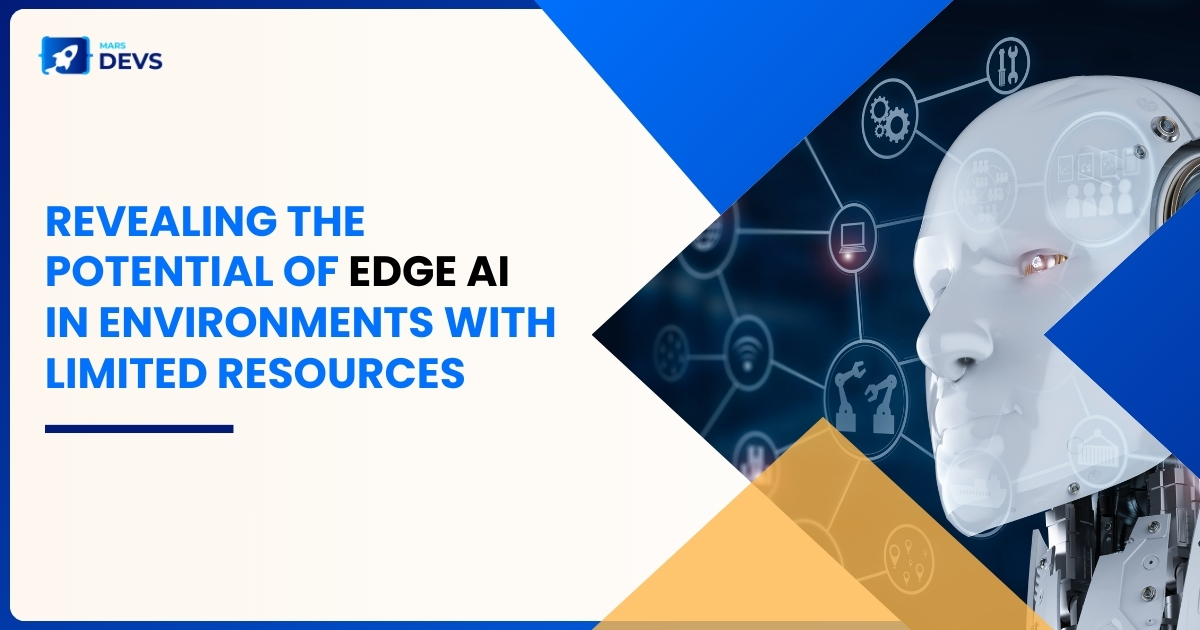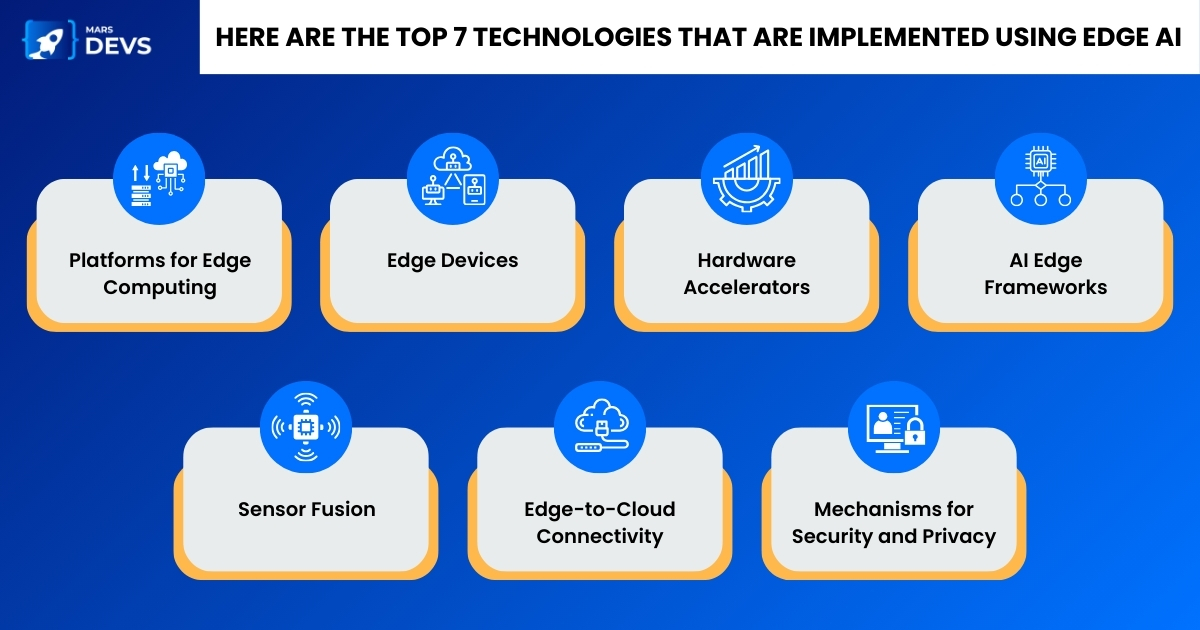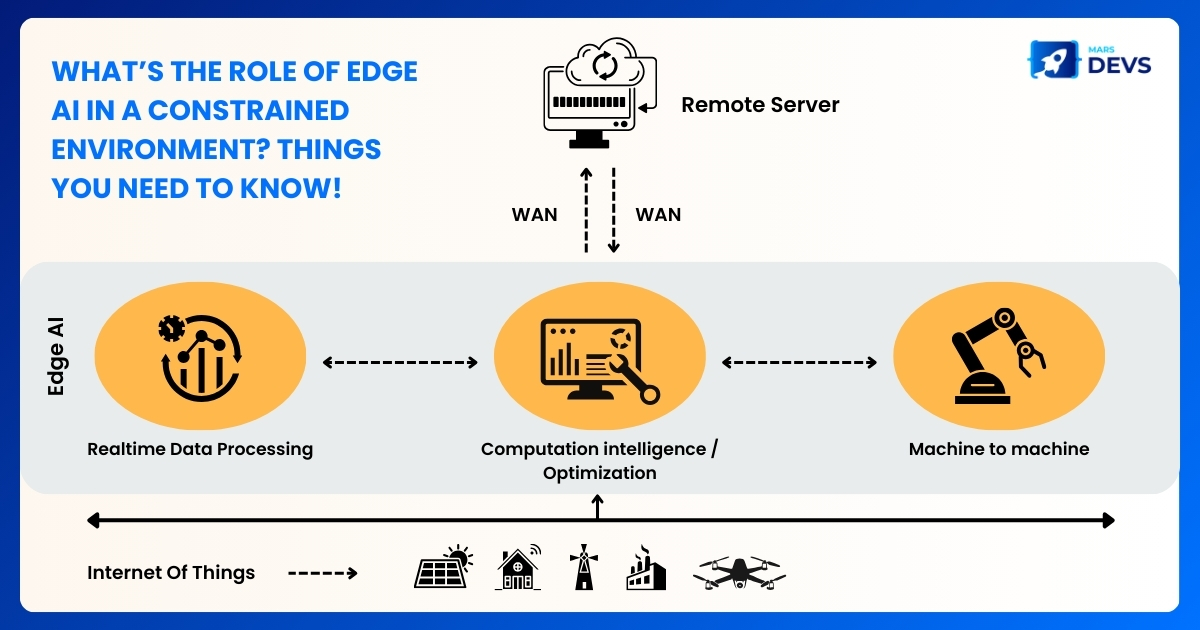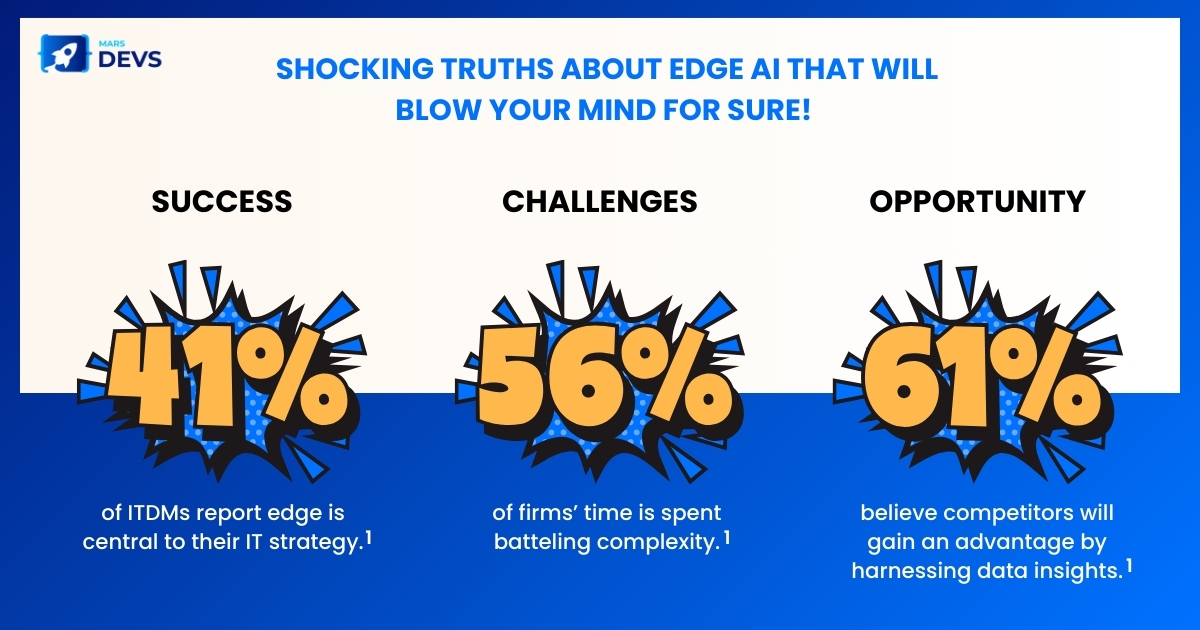Unleash the Potential of Edge AI in Resource-Constrained Environments
 Mars Devs
Mars Devs
The demand for accurate information and quick data collection in today's data-driven society have brought Edge AI to the forefront of technological innovation. This tendency is particularly significant in settings with limited resources when more conventional data processing techniques might not be possible or practicable.
Edge Artificial Intelligence (AI) transforms several industries by utilizing advanced algorithms at the data source and leveraging the processing capacity of edge devices. Edge AI provides unmatched efficiency and efficacy for improving manufacturing processes at remote industrial sites, providing exact healthcare in rural areas, and monitoring environmental conditions in difficult terrains.
It’s a vital tool for businesses working in restricted locations due to its independence and lack of need for centralized infrastructure or fast internet access. Edge AI has the potential to change businesses and inspire innovation in resource-constrained environments around the world as it develops and grows.
This MarsDevs post will let you know the real potential of edge AI. So, let’s get started!
Let’s Understand About Edge AI
Edge AI, also known as Edge Artificial Intelligence, is a change in computing that involves the direct implementation of AI models and algorithms on edge devices, such as industrial machines, cameras, and sensors, compared to a reliance on centralized cloud servers for computing.
This decentralized method allows for real-time analysis and decision-making at the network's edge by bringing intelligence and computing closer to the data source. The capacity of Edge AI to overcome the drawbacks of standard cloud-based AI systems is one of its main benefits, especially in environments with limited resources.
Edge AI improves privacy and security, lowers latency, and uses less bandwidth by processing data locally on edge devices. This is especially helpful in situations like industrial automation, driverless cars, or medical monitoring when real-time data are important.
With this, businesses can gain actionable insights from data, eliminating the demands to send huge amounts of unprocessed data to central servers for processing. This reduces bandwidth, and network congestion by making apps run well in settings with poor or unavailable access.
Also, its scalability and flexibility enable businesses to implement AI-driven solutions in a wide range of contexts, including urban infrastructure and rural agricultural areas. It is set up to create innovation and open new opportunities in multiple sectors as edge device capabilities may grow and AI algorithms become more advanced.
Technologies Implemented in Edge AI

Edge artificial intelligence (AI) is a software and hardware technology for intelligent processing and decision-making at the network's edge. Among the major technologies that make use of it are:
Platforms for Edge Computing: They offer the software frameworks and hardware required to install and maintain AI models on edge devices. They frequently come with tools for integrating edge hardware components for developing, deploying, and monitoring models.
Edge Devices: The hardware can implement & run AI models. Autonomous cars, industrial machinery, sensors, and cameras are examples of edge devices. They have the memory, processing power & connection needed for local AI inference tasks.
Hardware Accelerators: To gain speed in AI calculations on edge devices, specialized hardware parts like GPUs (Graphics Processing Units), TPUs (Tensor Processing Units), and FPGAs (Field-Programmable Gate Arrays) are frequently used. These accelerators enable real-time inference in resource-constrained contexts by enhancing performance and energy efficiency.
AI Edge Frameworks: It is used to optimize and deploy AI models on edge devices, frameworks such as ONNX Runtime, PyTorch Mobile, TensorFlow Lite, and TensorFlow.js offer libraries and tools. They allow developers to create unique models suited to certain edge computing applications or to use pre-trained models.
Sensor Fusion: These techniques can combine data from many sensors and get helpful insights in settings where several sensors are placed on edge devices. This integrates data from several sources to provide more reliable and accurate AI inference.
Edge-to-Cloud Connectivity: Although Edge AI places a strong emphasis on local processing, there are situations in which access to cloud services is necessary for activities like data aggregation, model upgrades, or long-term analytics. Technology such as WebSocket, HTTP/REST APIs, and MQTT allow edge devices and cloud systems to communicate with one another effortlessly.
Mechanisms for Security and Privacy: Because Edge AI systems split up, strong security controls are necessary to safeguard data and stop illegal access. Secure bootstrapping, authentication, and encryption are techniques to protect edge devices and data transmission routes.
Role of Edge AI in Constrained Environment

To solve the difficulties presented by little resources, poor connection, and strict operating constraints, edge artificial intelligence (AI) plays a critical role in confined contexts. In these kinds of settings, Edge AI performs the following crucial roles:
Localized Processing: Edge AI can process data locally on edge devices in contexts with limited bandwidth and computing power. This minimizes latency and conserves bandwidth by eliminating the need to transfer massive amounts of raw data to centralized servers for processing.
Real-time Decision-Making: To react quickly to events or situations that change, constrained settings sometimes call for real-time decision-making. With Edge AI, real-time data stream analysis is made possible without external servers or internet access, allowing quick insights and action.
Bandwidth Conservation: Edge AI reduces reliance on centralized data centers and cloud services, frees up bandwidth, and reduces network congestion. Edge AI can use existing resources by processing data locally, reducing the quantity of data that needs to be transferred via constrained network connections.
Autonomy and Resilience: By allowing edge devices to function independently, Edge AI offers autonomy and resilience where internet access is irregular or unpredictable. This guarantees ongoing operation and the ability to make decisions even in a brief loss of connectivity.
Privacy and Security: By processing sensitive data locally on edge devices, edge AI improves privacy and security by lowering the possibility of data breaches or unwanted access during data transfer. This is especially crucial in contexts with limited resources when maintaining data privacy is vital.
Personalization and Flexibility: Edge AI enables personalization and flexibility in response to particular limitations and environmental demands. AI models may be configured to function well with constrained resources, maximizing efficiency and consuming the least amount of resources possible.
Scalability: Edge AI solutions are scalable to meet changing demands and workloads since they may be implemented over a network of locations of edge devices. Because of this flexibility, businesses may increase their AI capabilities to meet environmental needs without overloading centralized infrastructure.
In summary, Edge AI enables enterprises functioning in restricted settings to surmount obstacles, attain streamlined operations & open fresh avenues for creativity.
Increasing Industrial Operations' Productivity
Edge AI enhances industrial productivity by providing real-time monitoring, predictive maintenance, and anomaly detection on the production floor. Through localized sensor and machinery data analysis, Edge AI reduces downtime, prevents expensive malfunctions, and enhances production procedures.
Extending asset lifespans, lowering operating costs, and improving equipment dependability, this proactive approach to maintenance eventually raises industrial operations' total productivity and efficiency.
Enabling Environmental Monitoring Using Precision Agriculture
Edge AI uses data from sensors, drones, and satellite pictures to provide real-time data that transforms precision agriculture and environmental monitoring. It’s used in precision agriculture to assess data on crop health, soil moisture, and nutrient levels to enhance pest control, fertilization, and irrigation techniques.
It helps farmers to make accurate decisions at the field level by giving them actionable information. This leads to increased yields, less resource use, and better sustainability. In the same way, Edge AI can environmental monitoring analyze data from remote sensors and provide real-time monitoring of biodiversity, water levels, and air quality.
This makes it possible to identify environmental changes, pollution events, or natural disasters early on for quick mitigation and action. Environmental monitoring becomes more responsive, economical, and efficient when AI algorithms are directly installed on edge devices. This helps with conservation efforts and ecosystem management in a variety of environments.
Transforming the Provision of Healthcare
By providing rapid, individualized, and accessible medical treatment, edge AI is transforming healthcare delivery, especially in poor or rural places.
With Edge AI capabilities, portable medical devices can do procedures like vital sign monitoring, and diagnosis, and even help with surgery without relying on centralized healthcare infrastructure or continuous internet access.
It helps to protect privacy and security while delivering real-time data for precise diagnostic and treatment decisions by analyzing patient data locally on the device. Furthermore, Edge AI makes telemedicine and remote patient monitoring possible, expanding the reach of healthcare practitioners outside of conventional clinical settings.
In the end, this decentralized strategy transforms healthcare delivery and raises the standard of living for communities all over the world. It also improves patient outcomes, lowers healthcare costs, increases access to healthcare, and gives people the capacity to take active control of their health.
Challenges
It faces many challenges when Edge AI works in contexts with limited resources. The limited processing power and memory of edge devices may limit the complexity and performance of deployed AI models.
Challenges can arise from data variability and quality, as distracting or insufficient data from sensors in these kinds of situations can make training and deploying models more difficult. Because it is decentralized, security and privacy issues might occur.
These include the possibility of malicious attacks on deployed algorithms or unauthorized access to sensitive data. The challenges turn worse by maintenance complications, scalability limitations & interoperability issues with the current infrastructure.
Regulatory compliance creates more challenges, especially in delicate industries like healthcare where concerns about data privacy and moral AI use are important. Network and connectivity issues, such as irregular or unstable internet connection, make it difficult for edge devices to communicate with centralized systems.
Overcoming these obstacles requires comprehensive approaches that include innovations in hardware, software, algorithms, and regulatory frameworks specifically designed to fit the special requirements of resource-constrained situations.
Conclusion

By providing intelligence straight to the data source, Edge AI has the potential to transform operations in settings with limited resources. Regardless of environmental constraints, this decentralized method enables enterprises to obtain useful information, improve workflows, and make wise decisions.
The fast advancement of Edge AI technologies is anticipated to impact several sectors, stimulating innovation and transforming the technological environment in resource-constrained circumstances.
With the capacity to surmount obstacles including constrained computational capacity, inconsistent data, and network problems, Edge AI is well-positioned to yield substantial advantages, such as heightened productivity, better healthcare provision, and environmentally sustainable monitoring.
In a short time, Edge AI's revolutionary effect is expected to reshape how humans engage with technology and handle the complexity of resource-constrained situations, as we see its continuous acceleration. Are you looking to incorporate edge AI into your resource-based environments? Grab a free 15-minute call with us today!
Subscribe to my newsletter
Read articles from Mars Devs directly inside your inbox. Subscribe to the newsletter, and don't miss out.
Written by

Mars Devs
Mars Devs
MarsDevs is a one-stop development shop! Our experienced and dedicated developers empower businesses and tech needs with outstanding code quality and excellent UIs. From ideation to development, deployment to management, we chip in anytime enterprises need. Ready to stand stronger with you, our tools include: - Python - Nodejs - Vuejs - Reactjs - Angular/Angularjs - React-Native - Flutter - AWS - GCP and more Each of them is chosen to create more efficient solutions faster. We believe in innovation and lead with consistent effort, dedication and flexibility. MarsDevs also provide Digital Marketing services like - Search Engine Optimization, Social Media Marketing, and Search Engine Marketing.